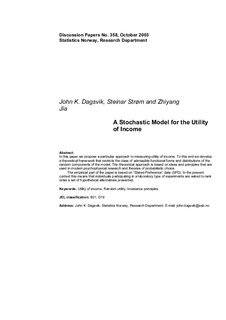| dc.contributor.author | Dagsvik, John K. | |
| dc.contributor.author | Strøm, Steinar | |
| dc.contributor.author | Jia, Zhiyang | |
| dc.date.accessioned | 2011-10-08T18:07:08Z | |
| dc.date.available | 2011-10-08T18:07:08Z | |
| dc.date.issued | 2003 | |
| dc.identifier.issn | 1892-753x | |
| dc.identifier.uri | http://hdl.handle.net/11250/180185 | |
| dc.description | Abstracts with downloadable PDF files of
Discussion Papers are available on the Internet: http://www.ssb.no | en_US |
| dc.description.abstract | Abstract:
In this paper we discuss a general framework for analyzing labor supply behavior in the presence of
complicated budget- and quantity constraints of which some are unobserved. The point of departure
is that an individual’s labor supply decision can be considered as a choice from a set of discrete
alternatives (jobs). These jobs are characterized by attributes such as hours of work, sector specific
wages and other sector specific aspects of the jobs. We focus in particular on theoretical justification
of functional form assumptions and properties of the random components of the model.
The paper includes an empirical application based on Norwegian data, in which the labor
supply of married women is estimated.
Keywords: Labor supply, non-convex budget sets, non-pecuniary job-attributes, sector-specific
wages. | en_US |
| dc.language.iso | eng | en_US |
| dc.publisher | Statistics Norway | en_US |
| dc.relation.ispartofseries | Discussion Papers;No. 358 | |
| dc.subject | Labor supply | en_US |
| dc.subject | Non-convex budget sets | en_US |
| dc.subject | Non-pecuniary job attributes | en_US |
| dc.subject | Sector-specific wages | en_US |
| dc.title | A stochastic model for the utility of income | en_US |
| dc.type | Working paper | en_US |
| dc.subject.nsi | VDP::Social science: 200::Economics: 210 | en_US |
| dc.subject.nsi | VDP::Mathematics and natural science: 400::Mathematics: 410::Statistics: 412 | en_US |
| dc.source.pagenumber | 40 s. | en_US |
